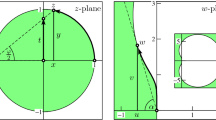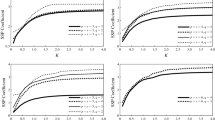Abstract
We analyze monotonicity, strong stability and positivity of the TR-BDF2 method, interpreting these properties in the framework of absolute monotonicity. The radius of absolute monotonicity is computed and it is shown that the parameter value which makes the method L-stable is also the value which maximizes the radius of monotonicity. In order to achieve unconditional monotonicity, hybrid variants of TR-BDF2 are proposed, that reduce the formal order of accuracy, while keeping the native L-stability property, which is useful for the application to stiff problems. Numerical experiments compare these different hybridization strategies to other methods used in stiff and mildly stiff problems. The results show that the proposed strategies provide a good compromise between accuracy and robustness at high CFL numbers, without suffering from the limitations of alternative approaches already available in literature.












Similar content being viewed by others
References
Bank, R., Coughran, W., Fichtner, W., Grosse, E., Rose, D., Smith, R.: Transient simulation of silicon devices and circuits. IEEE Trans. Electron Devices 32, 1992–2007 (1985)
Bellen, A., Jackiewicz, Z., Zennaro, M.: Contractivity of waveform relaxation Runge–Kutta iterations and related limit methods for dissipative systems in the maximum norm. SIAM J. Numer. Anal. 31(2), 499–523 (1994)
Bellen, A., Torelli, L.: Unconditional contractivity in the maximum norm of diagonally split Runge–Kutta methods. SIAM J. Numer. Anal. 34(2), 528–543 (1997)
Bertolazzi, E.: Positive and conservative schemes for mass action kinetics. Comput. & Math. Appl. 32(6), 29–43 (1996)
Burchard, H., Deleersnijder, E., Meister, A.: A high-order conservative Patankar-type discretisation for stiff systems of production–destruction equations. Appl. Numer. Math. 47, 1–30 (2003)
Butcher, J., Chen, D.: A new type of singly-implicit Runge–Kutta method. Appl. Numer. Math. 34, 179–188 (2000)
Calvo, M., de Frutos, J., Novo, J.: Linearly implicit Runge–Kutta methods for advection-diffusion-reaction equations. Appl. Numer. Math. 37, 535–549 (2001)
Constantinescu, E., Sandu, A.: Multirate timestepping methods for hyperbolic conservation laws. J. Sci. Comput. 33, 239–278 (2007)
Dekker, K., Verwer, J.: Stability of Runge–Kutta Methods for Stiff Nonlinear Differential Equations. Elsevier, North Holland (1984)
Duraisamy, K., Baeder, J.: Implicit scheme for hyperbolic conservation laws using nonoscillatory reconstruction in space and time. SIAM J. Sci. Comput. 29(6), 2607–2620 (2007)
Duraisamy, K., Baeder, J., Liu, J.G.: Concepts and application of time-limiters to high resolution schemes. J. Sci. Comput. 19, 139–162 (2003)
Ferracina, L., Spijker, M.: Stepsize restrictions for the total-variation-diminishing property in general Runge–Kutta methods. SIAM J. Numer. Anal. 42(3), 1073–1093 (2004)
Ferracina, L., Spijker, M.: An extension and analysis of the Shu–Osher representation of Runge–Kutta methods. Math. Comput. 74(249), 201–219 (2005)
Ferracina, L., Spijker, M.: Strong stability of singly-diagonally-implicit Runge–Kutta methods. Appl. Numer. Math. 58, 1675–1686 (2008)
Formaggia, L., Scotti, A.: Positivity and conservation properties of some integration schemes for mass action kinetics. SIAM J. Numer. Anal. 49(3), 1267–1288 (2011)
Giraldo, F., Kelly, J., Constantinescu, E.: Implicit–explicit formulations of a three-dimensional nonhydrostatic unified model of the atmosphere (NUMA). SIAM J. Sci. Comput. 35(5), 1162–1194 (2013)
Gottlieb, S., Ketcheson, D., Shu, C.W.: Strong Stability Preserving Runge–Kutta and Multistep Time Discretizations. World Scientific, Singapore (2011)
Gottlieb, S., Shu, C.: Total variation diminishing Runge–Kutta schemes. Math. Comput. 67(221), 73–85 (1998)
Gottlieb, S., Shu, C., Tadmor, E.: Strong stability-preserving high-order time discretization methods. SIAM Rev. 43(1), 89–112 (2001)
Hairer, E., Lubich, C., Wanner, G. (eds.): Geometric Numerical Integration, 2nd edn. Springer, Heidelberg (2006)
Hairer, E., Nørsett, S., Wanner, G.: Solving Ordinary Differential Equations I: Nonstiff Problems, 3 corr. edn. Springer, Heidelberg (2008)
Hairer, E.: Solving Ordinary Differential Equations II: Stiff and Differential-Algebraic Problems, 2 rev. edn. Springer, Heidelberg (2002)
Higueras, I.: On strong stability preserving time discretization methods. J. Sci. Comput. 21, 193–223 (2004)
Higueras, I.: Representations of Runge–Kutta methods and strong stability preserving methods. SIAM J. Numer. Anal. 43(3), 924–948 (2005)
Higueras, I.: Strong stability for Runge–Kutta schemes on a class of nonlinear problems. J. Sci. Comput. 57(3), 518–535 (2005)
Higueras, I.: Strong stability for additive Runge–Kutta methods. SIAM J. Numer. Anal. 44(4), 1735–1758 (2006)
Higueras, I., Roldán, T.: Stage value predictors for additive and partitioned Runge–Kutta methods. Appl. Numer. Math. 56, 1–18 (2006)
Hosea, M., Shampine, L.: Analysis and implementation of TR-BDF2. Appl. Numer. Math. 20, 21–37 (1996)
Hundsdorfer, W., Mozartova, A., Spijker, M.: Special boundedness properties in numerical initial value problems. BIT 51(4), 909–936 (2011)
Hundsdorfer, W., Ruuth, S., Spiteri, R.: Monotonicity-preserving linear multistep methods. SIAM J. Numer. Anal. 41(2), 605–623 (2003)
Hundsdorfer, W., Spijker, M.: Boundedness and strong stability of Runge–Kutta methods. Math. Comput. 80(274), 863–886 (2011)
Hundsdorfer, W., Verwer, J.: Numerical Solution of Time-Dependent Advection-Diffusion-Reaction Equations. Springer, Heidelberg (2003)
Ketcheson, D.: Step sizes for strong stability preservation with downwind-biased operators. SIAM J. Numer. Anal. 49(4), 1649–1660 (2011)
Ketcheson, D., Gottlieb, S., Macdonald, C.: Strong stability preserving two-step Runge–Kutta methods. SIAM J. Numer. Anal. 49(9), 2618–2639 (2011)
Ketcheson, D., Macdonald, C., Gottlieb, S.: Optimal implicit strong stability preserving Runge–Kutta methods. Appl. Numer. Math. 59, 373–392 (2009)
Ketcheson, D., Macdonald, C., Ruuth, S.: Spatially partitioned embedded Runge–Kutta methods. SIAM J. Numer. Anal. 51(5), 2887–2910 (2013)
Kraaijevanger, J.: Contractivity of Runge–Kutta methods. BIT 31, 482–528 (1991)
Lefever, R., Nicolis, G.: Chemical instabilities and sustained oscillations. J. Theor. Biol. 30, 267–284 (1971)
LeVeque, R.: Finite Volume Methods for Hyperbolic Problems. Cambridge University Press, Cambridge (2002)
Liu, H., Zou, J.: Some new additive Runge–Kutta methods and their applications. J. Comput. Appl. Math. 190, 74–98 (2006)
Macdonald, C., Gottlieb, S., Ruuth, S.: A numerical study of diagonally split Runge–Kutta methods for PDEs with discontinuities. J. Sci. Comput. 35, 89–112 (2008)
Sandu, A.: Positive numerical integration methods for chemical kinetic systems. J. Comput. Phys. 170, 589–602 (2001)
Shu, C.: Total-variation-diminishing time discretization. SIAM J. Sci. Stat. Comput. 9(6), 1073–1084 (1988)
Shu, C., Osher, S.: Efficient implementation of essentially non-oscillatory shock-capturing schemes. J. Comput. Phys. 77, 439–471 (1988)
Spijker, M.: Contractivity in the numerical solution of initial value problems. Numerische Mathematik 42(3), 271–290 (1983)
Spijker, M.: Stepsize conditions for general monotonicity in numerical initial value problems. SIAM J. Numer. Anal. 45(3), 1226–1245 (2007)
Sportisse, B.: An analysis of operator splitting techniques in the stiff case. J. Comput. Phys. 161, 140–168 (2000)
Tumolo, G., Bonaventura, L.: A semi-implicit, semi-Lagrangian discontinuous Galerkin framework for adaptive numerical weather prediction. Q. J. R. Meteorol. Soc. 141, 2582–2601 (2015)
van Veldhuizen, S., Vuik, C., Klein, C.: A note on the numerical simulation of Kleijn’s benchmark problem. Report 06–15, Delft University of Technology, Dept. of Applied Mathematical Analysis (2006)
van Veldhuizen, S., Vuik, C., Klein, C.: Comparison of ODE methods for laminar reacting gas flow simulations. Numer. Methods Partial Differ. Equ. 24(3), 1037–1054 (2008)
Verwer, J., Spee, E., Blom, J., Hundsdorfer, W.: A second-order Rosenbrock method applied to photochemical dispersion problems. SIAM J. Sci. Comput. 20(4), 1456–1480 (1999)
Acknowledgments
We would like to thank two anonymous reviewers for their constructive criticism, which has greatly helped to improve the original version of this paper. A.D.R. would like to thank Tenova S.p.A. for sponsoring his Executive Ph.D. at Politecnico di Milano and all the faculty members at the Department of Mathematics for their continuous support. L.B. acknowledges financial support from the INDAM - GNCS project ’Metodi numerici semi-impliciti e semi-Lagrangiani per sistemi iperbolici di leggi di bilancio’. Useful discussions with L. Formaggia and A. Scotti at MOX on the topics studied in this paper are kindly acknowledged.
Author information
Authors and Affiliations
Corresponding author
Additional information
Partially supported by the INDAM - GNCS project ’Metodi numerici semi-impliciti e semi-Lagrangiani per sistemi iperbolici di leggi di bilancio’.
Appendices
Appendix 1: Additional Results on Monotonicity
Discrete maximum principle. The discrete maximum principle is closely related to the property of monotonicity.
Definition 7
Discrete Maximum Principle. The RK method (2) respects the discrete maximum principle if \(\forall u \,{\in }\, \mathbb {R}^m\) it guarantees that
under the assumption that for \(0 \,{<}\, h \,{\le }\, \tau _{0}\) and \(\forall u \,{\in }\, \mathbb {R}^m\) with components \(u_p\)
Similarly to the other properties, range boundedness may be verified under a step size restriction analogous to (5). Again following [29] and [46], we introduce two relevant sublinear functionals, denoted as max and min functional
which allow us to write the assumption (47) in the form (3). By assuming the monotonicity property 1 under the functionals (48) the discrete maximum principle 7 directly follows.
Contractivity. Contractivity of numerical approximations has been extensively studied. Relevant conclusions on step size conditions for contractivity have been given in [45], while contractivity of RK for nonlinear problems was thoroughly examined in [37].
Definition 8
Contractivity. The RK method (2) is contractive if \(\Vert \tilde{u}^{n} - u^{n}\Vert \,{\le }\, \Vert \tilde{u}^{n-1} - u^{n-1}\Vert \) under the assumption that
Usually, Definition 8 is verified under a step size restriction in the form of (5). For conditional contractivity, the circle condition that was originally assumed in [37] is
It was shown later in [24] that this condition can be considered as a special form of (3). By introducing the auxiliary space \(\mathbb {V} \,{=}\, \mathbb {R}^m\times \mathbb {R}^m\) and considering \(\Vert G_i\Vert \,{=}\,\Vert \tilde{g}^i - g^i\Vert \) and \(\Vert U_i\Vert \,{=}\,\Vert \tilde{u}_i^{n} - u_i^{n}\Vert \) the circle condition (49) can be reformulated as (3) in the space of perturbations. See also [46] for additional considerations on these issues.
Appendix 2: Tables of Errors and Workload in Numerical Experiments
Here we report the Tables 8, 9, 10, 11, and 12 of the errors and workload as measured during the numerical experiments to show the typical error magnitude and workload to be expected from the different methods. We dot not claim that the error-workload tables reported here are immediately relevant for the selection of step sizes or numerical methods, but we consider them as representative of the relative workload to be expected from the methods assessed.
Rights and permissions
About this article
Cite this article
Bonaventura, L., Rocca, A.D. Unconditionally Strong Stability Preserving Extensions of the TR-BDF2 Method. J Sci Comput 70, 859–895 (2017). https://doi.org/10.1007/s10915-016-0267-9
Received:
Revised:
Accepted:
Published:
Issue Date:
DOI: https://doi.org/10.1007/s10915-016-0267-9




